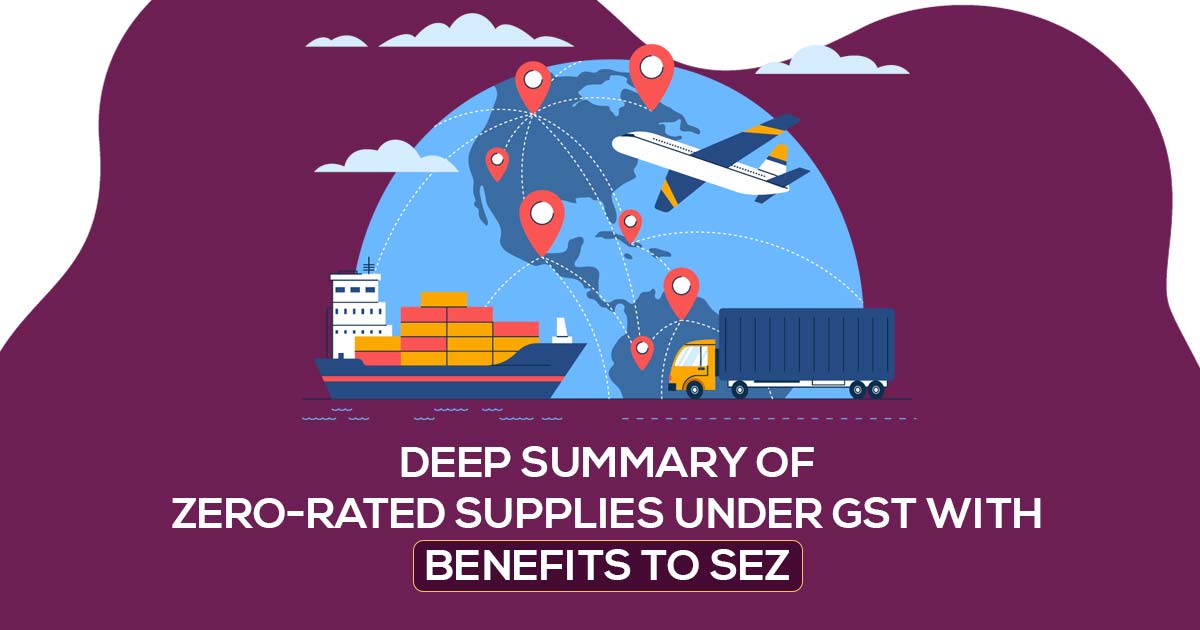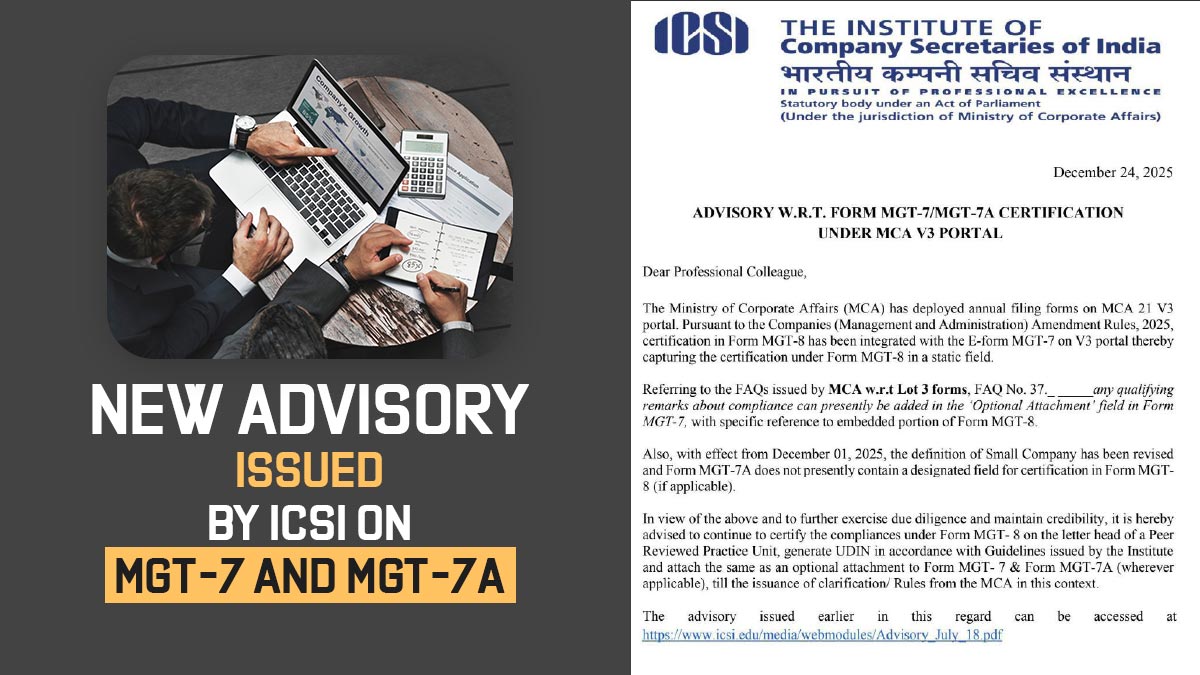
In 2017, the GST which is a destination-based consumption tax was incorporated. As per the GST framework, particularly for the businesses that are involved in the exports and supplying the Special Economic Zones (SEZs), the concept of zero-rated supply poses influential importance.
The provision of goods or services that are either exported or provided to SEZs and are not subject to GST in India is referred to as zero-rated supply. The fundamental goal of zero-rating supply is to boost exports and SEZs, both of which are critical to the Indian economy.
Exports of goods and services have traditionally been a vital engine of economic growth and development, and the zero-rated supply provisions under GST provide Indian exporters with a considerable boost by allowing them to compete in the global market. Additionally, zero-rating supplies to SEZs aid in the creation of a business-friendly atmosphere and the promotion of investment in SEZs.
The purpose of this article is to offer a thorough explanation of GST zero-rated supplies, including the idea, legislative framework, and eligibility requirements for such supplies. We will also talk about how zero-rated goods affect businesses and the Indian economy.
Main Concept & Legal Framework About Zero-rated Supplies Under GST
The provision of goods or services that are exempt from GST under Indian GST law is referred to as zero-rated supply. It is vital to distinguish zero-rated goods from exempt supplies since exempt supplies are tax-free, but zero-rated supplies are taxed but are eligible for input tax credit (ITC) advantages. The fundamental goal of zero-rating supply is to boost exports and SEZs, both of which are critical to the Indian economy.
The provision of the zero-rated supplies mentioned under section 16 of the Integrated Goods and Services Tax (IGST) Act, 2017, concerns the ITC entitlement on the exports or zero-rated supplies. A registered person who incurs zero-rated supplies is qualified for claiming a refund of the unused ITC on goods or services or both that are used for these types of supplies, under Section 16(1) of the IGST Act. A registered individual who makes zero-rated supplies might either export the goods or services beneath the bond or Letter of Undertaking (LUT) or claim a refund of the unutilized ITC furnished under Section 16(2) of the IGST act.
Section 2(6) of the IGST act describes the zero-rated supply as any taxable supply of the goods or services or both:
- Export of goods or services or both
- Supply of goods or services or both to a Special Economic Zone (SEZ) developer or an SEZ unit.
Since zero-rated supplies are planned for consumption outside India and would not be levied to GST thus the exports of goods or services would be acknowledged as zero-rated supplies. The exports should follow the required documentation and process for entitling as zero-rated supplies in order to ship the goods and services and comply with the specified date for filing the returns.
Important: GST (Goods and Services Tax) Impact on Export Incentives
The goods or services supplied to SEZ developers or units are regarded as zero-rated supplies. The SEZ scheme was incorporated to promote exports and generate employment opportunities in the country. The goods or services supplied to SEZs would be exempted from GST given that the supplier receives the Letter of Undertaking or files a bond with the proper authorities. SEZ secures its own statute and would be controlled by the SEZ act 2005.
Therefore the zero-rated supplies would play an important role in the promotion of the exports and SEZs in India. The lawful framework for the zero-rated supplies furnished beneath the IGST act and the businesses involved in these supplies could claim for the ITC refunds or chooses for the bond or LUT. Under the GST in India, the goods or services exports and supplies to the SEZs would be the two examples of zero-rated supplies.
Supplying Zero-rated Goods or Services Via Export Under GST
For the economic growth and development in India, the export of goods or services would be an important driver. Exports of goods or services are regarded as zero-rated supplies under the GST regime which directs that they are GST exempted. The primary goal of zero-rating supply is to stimulate exports and assist Indian enterprises in competing in the global market.
Under GST the export directs to the supply of goods or services that are planned for consumption outside India. The term “export” would be specified under Section 2(5) of the IGST Act, 2017, “export of goods” implies taking goods out of India to a place outside India. Likewise, “export of services” signifies the supply of any service when:
- The supplier of service is located in India
- The recipient of the service is located outside of India
- The place of supply of service would be located outside of India
- The payment for these services is obtained in convertible foreign exchange
Businesses must meet specific qualifying conditions in order for their exports to be designated zero-rated supply under GST. Obtaining the relevant documentation, such as a shipping bill, invoice, and other documents needed by the Customs Act of 1962, is one of the important requirements. The exporter must also stick to the required dates for filing returns and follow the right procedure for shipping the goods or services.
Under GST law in order to claim the benefits of zero-rated supplies the exporter should furnish the refund application. Within 2 years the refund application should be furnished from the pertinent date mentioned under Section 54(1) of the CGST Act, 2017. Either the date of issue of the invoice or the date of payment of tax, whichever is later would be the appropriate date for filing the GST refund claim.
The advantages of zero-rated supplies under GST for exporting enterprises are numerous. To begin, exporters can request a refund of any unused ITC on goods, services, or both that are used for such supply. This lowers the cost of exports and allows exporters to compete in the global market. Second, the GST exemption makes Indian exports more competitive in the worldwide market, which encourages economic growth and development.
However, compliance and documentation issues are among the most pressing issues confronting exporting businesses. Exporters must ensure that all necessary documentation is in place and that all shipping procedures are strictly followed. Failing to comply with the stipulated dates or produce the relevant papers may result in delays or denial of refund claims. Furthermore, the refund procedure itself can be time-consuming and inconvenient, affecting firms’ cash flow.
To summarise, exports of goods or services are considered zero-rated supply under GST, and enterprises must meet the requisite eligibility conditions in order to collect ITC refunds. The advantages of zero-rated goods for exporting organizations are important, and it aids in encouraging exports and growing the Indian economy. Compliance-related problems and paperwork requirements, on the other hand, can be a barrier for businesses, and it is critical to ensure that the relevant procedures are followed in order to claim the advantages of zero-rated goods.
Zero-rated Supplies to SEZs Under the GST
SEZs are designated regions inside a country that are intended to encourage exports, attract foreign investment, and provide job opportunities. SEZs were implemented in India in 2005 and have contributed significantly to the country’s economic progress. Supplies made to SEZs are considered zero-rated supplies under GST rules.
Basic Idea and Role of SEZs in the Indian Economy
SEZs are intended to foster the formation and growth of industries, particularly those focused on exports. These zones are set up in order to create a fair playing field for enterprises operating in the global market. SEZs have been established in India in a variety of industries, including information technology, manufacturing, biotechnology, and pharmaceuticals.
Supply Eligibility Criteria for Zero-rated Supplies to SEZs
Supplies made to SEZs are treated as zero-rated under the GST law when the supplier meets some conditions. To claim the advantage of zero-rating, the supplier would be needed to file the LUT (Letter of Undertaking) or a bond to the related heads. A bond or LUT would act as a guarantee that the supplier shall follow the conditions specified through the GST law. The supplier should assure that the goods or services provided would get obtained via the SEZ unit or the developer and would be utilized for the trusted functions.
Read Also: Difference Guide: Exempted, Non-GST, NIL, Zero Rated Supplies
All Benefits of Zero-rated Supplies to Special Economic Zones
Supplies treatment which is incurred to SEZs as zero-rated supplies furnish various advantages to the SEZ unit/developer and supplier. The biggest benefit is that these supplies would get GST exempted which diminishes the goods or services for the SEZ unit/developer cost. The same exemption would permit the SEZs to become competitive and draw much more investment directing to a surge in economic activity and chances of employment.
The additional benefit of zero-rated supplies would be that they permit smooth credit flow. The supplier is enabled to claim for the ITC upon the inputs, input services, and capital goods which are utilised in the supply of goods or services to SEZs. The ITC can be used to offset the GST liability on other supplies or seek a refund.
Apart from the benefits, zero-rated supply to SEZs present certain compliance and verification problems. To take advantage of the zero-rating benefit, the provider must follow the requirements outlined in the GST statute. These requirements include acquiring a LUT or bond, keeping adequate documentation, and adhering to the filing deadlines. Noncompliance with the requirements may result in the rejection of the zero-rating benefit and the imposition of fines.
The zero-rating of supplies to SEZs is an important element in the GST law that intends to stimulate exports, attract foreign investment, and generate job opportunities. The classification of such supplies as zero-rated supplies helps both the provider and the SEZ unit/developer. Nevertheless, compliance with the GST law’s restrictions is required to take advantage of the zero-rating benefit. As SEZs continue to play an important part in India’s economic growth, the importance of zero-rated supplies to SEZs is expected to expand.
Closure: For the promotion of exports and supporting the development of SEZs in India, zero-rated supplies would be critical. It is directed to the supplies where there is no GST imposed and the businesses involved in these supplies are enabled to claim the ITC refunds. The statute framework for the zero-rated supply would be regulated by section 16 of the IGST Act and Section 2(6) of the IGST Act.
The two examples of zero-rated supplies are the Export of goods or services and supplies to SEZs. Following the required process and documentation could be tough but businesses could have the advantage from the benefits of the zero-rated supplies like GST exemption, the surge in the export-based companies, and surged competitiveness in the global market.










Thanks, Arpit Kulshrestha, I would like to ask for your help. We are in SEZ as part of our business operations we use to purchase Patterns/Moulds with a Few suppliers. We will not bring these patterns/molds from the Supplier, because once the Patterns are ready supplier needs to manufacture the Materials in line with our designs. As we are not bringing these patterns supplier is asking us to Pay GST, and Zero rated supply is not applicable. can you pls help how to proceed? Any provision is available to get Zero rated supply. In the past few patterns, we paid with GST and applied for a Refund. GSTN Department rejected our refund request and told us we are already eligible for Zero rated supply and don’t pay GST.
“Please consult GST practitioner”